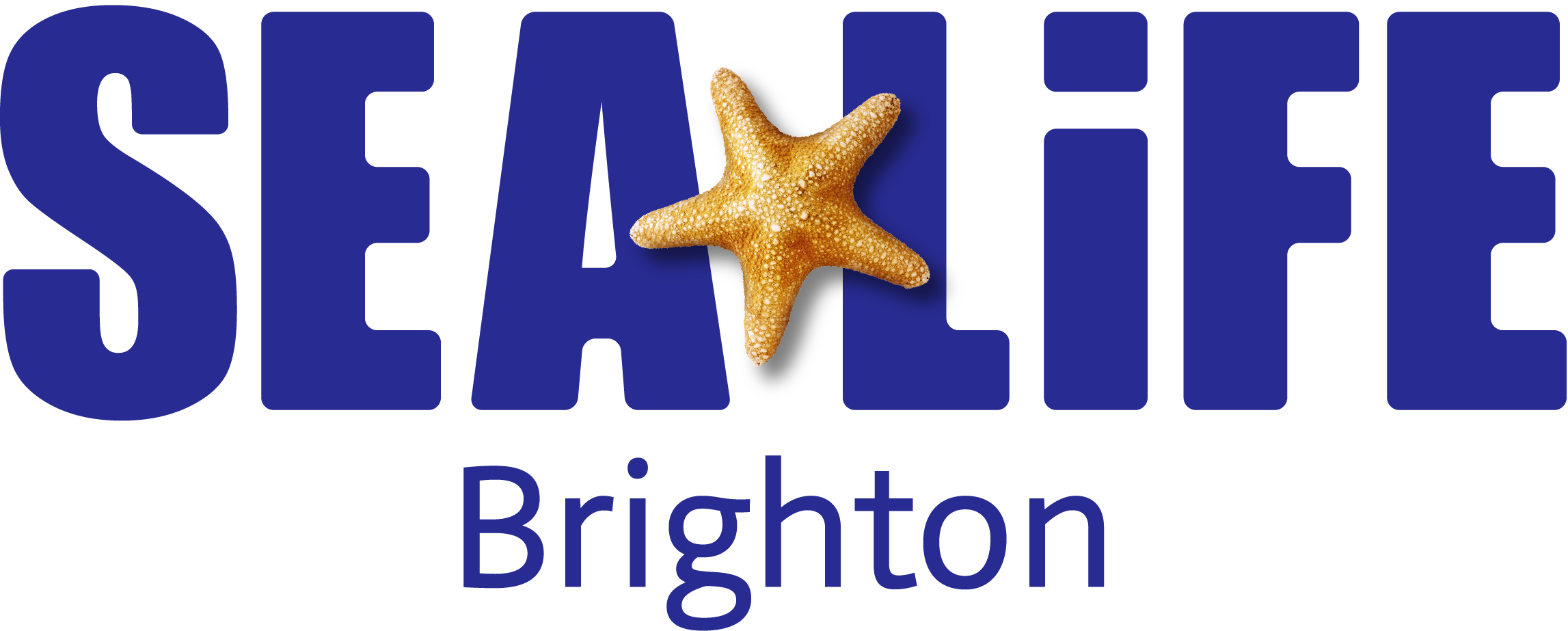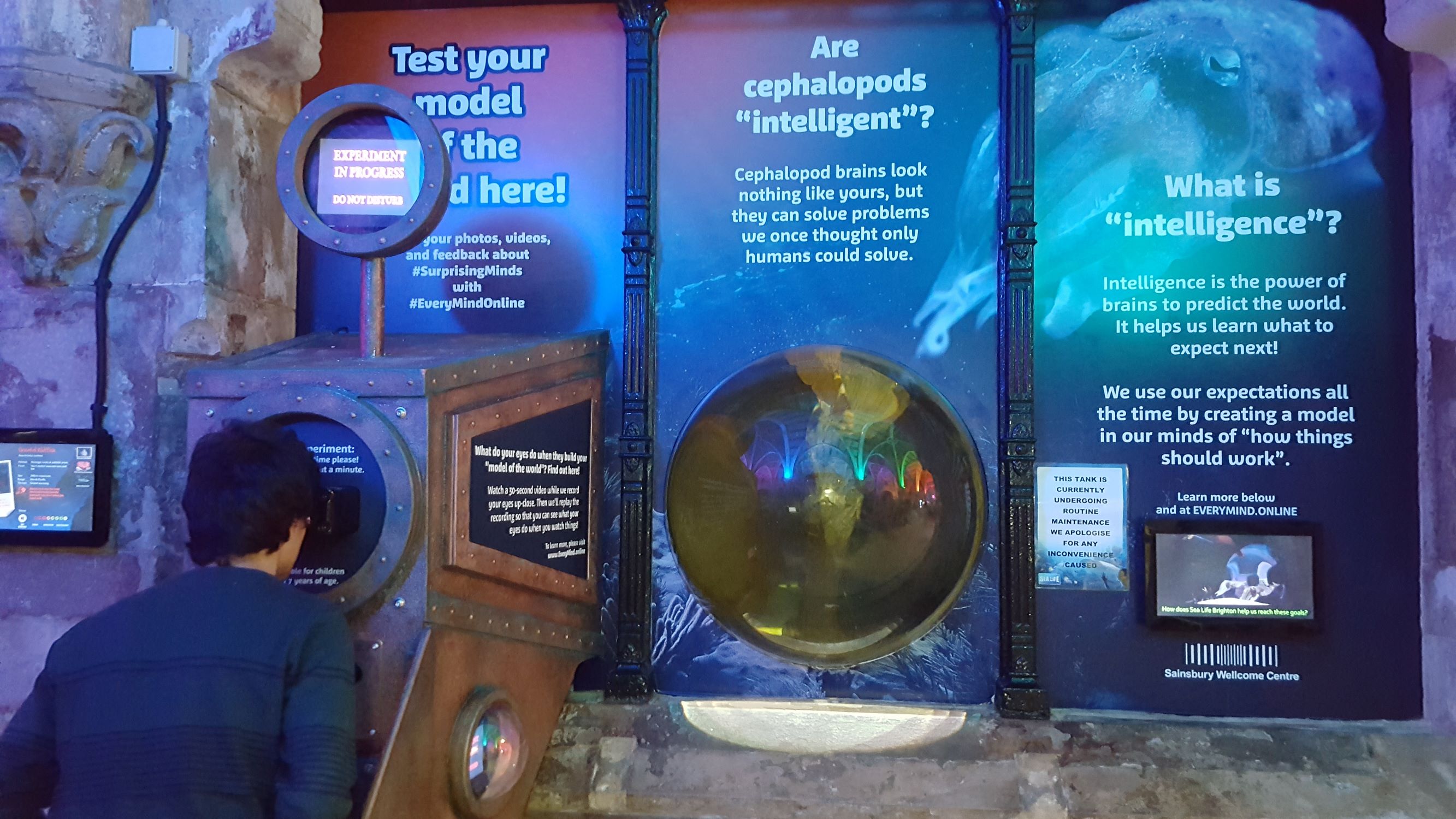In July 2017, we installed an interactive science exhibit at Sea Life Brighton in order to explore a new way to ask scientific questions about behaviour and the mind “in the wild”. We hope that the exhibit will help us make research in neuroscience and cognitive science more inclusive and accessible to the general public.
Our exhibit is located next to the cuttlefish display tank in the main arcade of Sea Life Brighton. Here we introduce Sea Life visitors to the main idea underlying comparative neuroscience: even brains that look totally different can evolve the same kinds of brain “powers”, for example, the power of “intelligence”.
What is ‘intelligence’?
Intelligence is the power of brains to predict the world. It helps us learn what to expect next!
We use our expectations all the time by creating a model in our minds of “how things should work.” Scientists call this your “model of the world”.
How do we create our ‘model of the world’?
We create our “model of the world” by collecting information about the world around us. While smells, sounds, tastes, feelings, and experiences are all part of our “model of the world”, the primary input device of human brains is our eyes.
What your eyes do when you create your ‘model of the world’?
Looking is one of the first behaviours we develop as infants, long before we learn how to talk. But have you ever seen your own eyes up close, to see what they do when they collect information about the world around you?
At the Surprising Minds exhibit, you can do exactly that! Come watch a 30-second video clip while we record your eyes up close. Then we’ll replay the recording so that you can see what your eyes do when you watch movies, or look at the world!
Want to learn more?
Check out our project blog for documentation of the project, and recent news and updates!
The software used to run the interactive station can be found in the Surprising Minds Exhibit github repository.
The code and workflow used to analyse the exhibit’s datasets can be found in the Surprising Minds Analysis github repository.
To read a summary, including figures and analysis plots, visit our Project Summary.
Share your thoughts, photos, and videos of the exhibit on twitter, instagram, and facebook using #surprisingminds and #everymindonline!
How to cite this project
Surprising Minds. Interactive installation and crowd human behaviour experiment. Installed 4 July 2017 at Sea Life Brighton, Brighton, UK. Kim D, Perkins K, Ramble C, Garnade H, Lopes G, Quinones D, Campbell-Russo R, Barrett R, Stopps M, The EveryMind Team, Kampff A.
Acknowledgements
| Danbee Kim | Project Co-Lead, Artistic and Scientific Director | International Neuroscience Doctoral Programme, Sainsbury Wellcome Centre for Neural Circuits and Behaviour |
| Kerry Perkins | Project Co-Lead | Sea Life Brighton |
| Clive Ramble | Design and Fabrication of outer casing for eye-tracking station | Sol Vin |
| Hazel Garnade | Design and Fabrication of outer casing for eye-tracking station | Sol Vin |
| Goncalo Lopes | Eyetracking Software | Sainsbury Wellcome Centre for Neural Circuits and Behaviour |
| Dario Quinones | Eyetracking Hardware | Sainsbury Wellcome Centre for Neural Circuits and Behaviour |
| Reanna Campbell-Russo | Pilot Data Collection | Nuffield Research Placements |
| Fedor Lischenko | Video content contributor | Russian Federal Research Institute of Fisheries and Oceanography |
| Caitlin O’Brien | Video content contributor | Université de Caen Normandie |
| Ryuta Nakajima | Video content contributor | Independent Artist |
| Roger T. Hanlon | Video content contributor | Marine Biological Laboratory, Woods Hole, USA |
| Joanna Nogueira | Video content contributor, Portuguese translator | Sainsbury Wellcome Centre for Neural Circuits and Behaviour |
| Lory Calcaterra | Italian translator, 3D design of custom camera holders | Sainsbury Wellcome Centre for Neural Circuits and Behaviour |
| Cédric Honnet | French translator | Sorbonne University, UPMC |
| Elena Zamfir | Romanian translator | Gatsby Computational Neuroscience Unit |
| Christian Niedworok | German translator | Sainsbury Wellcome Centre for Neural Circuits and Behaviour |
| Kevin Li | Chinese translator | Gatsby Computational Neuroscience Unit |
| Alex Gomez-Marin | Spanish translator | Instituto de Neurociencias de Alicante |
| Seong-Gon Kim | Korean translator | Mississippi State University |
| George Dimitriadis | Greek translator | Sainsbury Wellcome Centre for Neural Circuits and Behaviour |
| Jesse Geerts | Dutch translator | Sainsbury Wellcome Centre for Neural Circuits and Behaviour |
| Kirsty McNaught | Eyetracking Systems Consultant | Gatsby Computational Neuroscience Unit |
| Ian Blaney | Stores and Logistics Manager | Sainsbury Wellcome Centre |
| Robb Barrett | Prototyping and fabrication assistance | Sainsbury Wellcome Centre |
| Martyn Stopps | Prototyping and fabrication assistance | Sainsbury Wellcome Centre |
| Karen Fergus | Administrative assistance | Sainsbury Wellcome Centre |
| Adam Kampff | PhD Advisor | Sainsbury Wellcome Centre for Neural Circuits and Behaviour |
Many additional thanks to
The EveryMind Team for continuous and unflagging support and enthusiasm;
Alice Taylor-Gee (Sainsbury Wellcome Centre) for nurturing a momentum for public outreach and engagement at the Sainsbury Wellcome Centre, and for connecting us with the Nuffield Research Placement program;
and Daniel Osorio (Sussex University) for initiating the collaboration with Sea Life Brighton.


